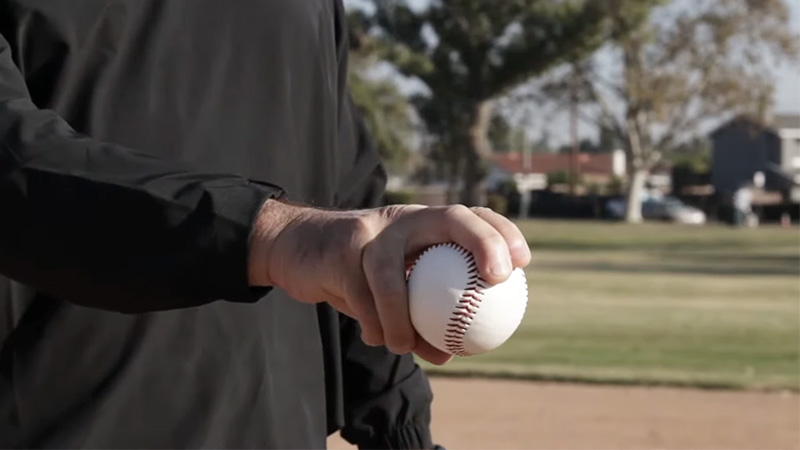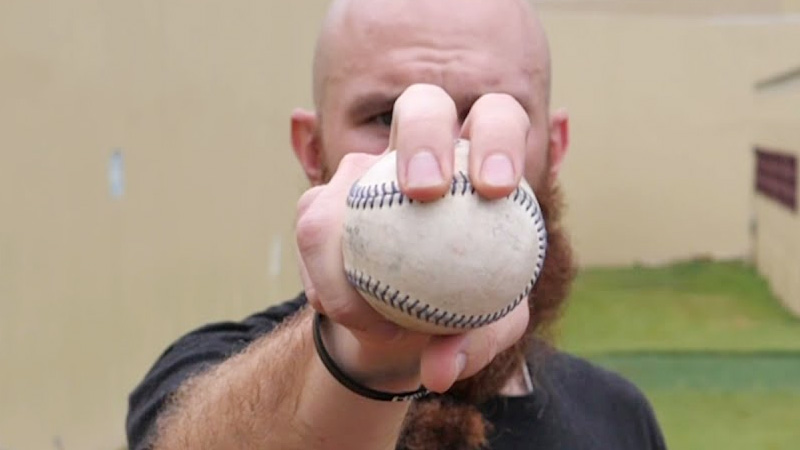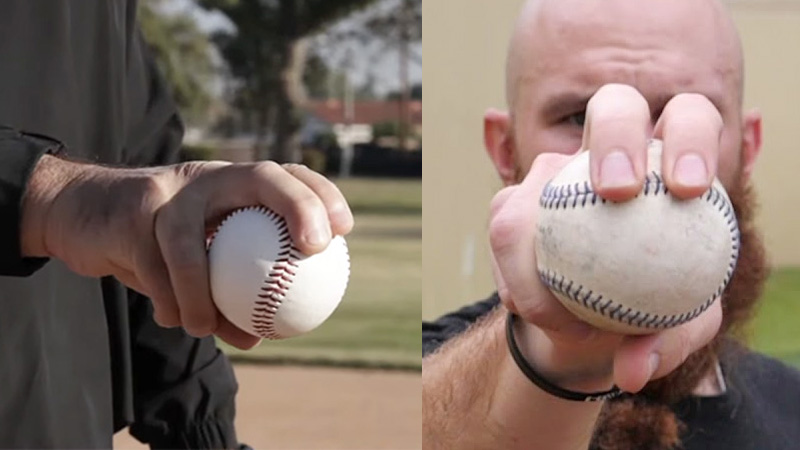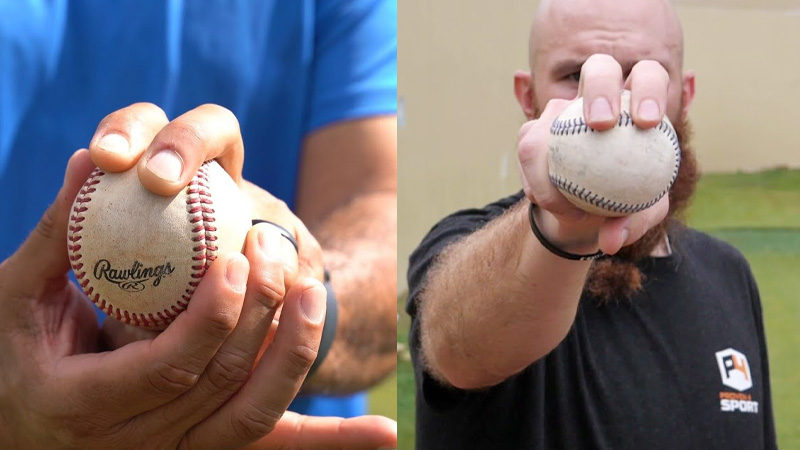When it is to the most common thrown pitches, you can’t talk much without two specific types of moderated pitches, 2 seam, and 4 seam fastballs. Though beginners understand these facts pretty soon, when it’s about 2 seam vs 4 seam fastball, they just lose their last clue.
Usually, these two types of pitches are not the same and they share a lot of differences. 2 seam and 4 seam fastballs have variations in grip, movement, speed, velocity, and even on purposes.
However, you must be here because you have issues understanding the facts, right? If yes, you must be on the right road. My discussion today will guide you to understand the fact, 2 seam vs 4 seam fastball effortlessly.
You just need to concentrate here and read this article till the end without skipping anything. Hopefully, you will get them soon. Well, then start this discussion with a proper introduction on 2-seam and 4 seam fastballs.
What is 2 Seam Fastball?
 Among all the thrown pitches, the two-seam fastball is the most common one. It is also known as the two-seamer. However, a two-seam fastball initially refers to the pitcher’s fastest pitches that don’t have quite the same velocity as the four-seam fastball.
Among all the thrown pitches, the two-seam fastball is the most common one. It is also known as the two-seamer. However, a two-seam fastball initially refers to the pitcher’s fastest pitches that don’t have quite the same velocity as the four-seam fastball.
Usually, a two-seam fastball is thrown by gripping the ball with two fingers along the seams that are closest together. And it will be thrown with the help of the pitcher’s index and middle fingers.
When the pitcher throws the ball properly, the two-seam fastball will move horizontally. It must be either towards the pitcher’s throwing arm side or away from it. This movement is caused by the way the ball spins as it is released from the pitcher’s hand.
When Should a Player Throw a 2 Seam Fastball?
A baseball player, both adult and young need to throw a 2 seam fastball in different situations, like:
- The player needs to throw it early in the count to establish control of the at-bat and set up other pitches.
- It is effective against hitters who tend to hit the ball on the ground, as the pitch’s movement can make it difficult for them to square up the ball and hit it hard.
- A 2 seam fastball can be a good pitch to throw when a pitcher is ahead in the count, as the batter may be more likely to swing at a pitch in an effort to avoid falling behind further.
- If there are runners on base, a pitcher might choose to throw a two-seam fastball in an effort to induce a ground ball double play.
- A 2 seam fastball can prevent the batters who are batting from the opposite side of the plate, as the pitch’s movement can make it difficult for them to see and hit the ball well.
What Is a 4-Seam Fastball?

Just like the 2 seam fastball, the four-seam fastball is known as a four-seamer. It is a type of pitch in baseball, thrown by gripping the ball with the index and middle fingers placed on top of the ball across the four seams that run perpendicular to the pitcher’s fingers.
It is literally the straightest and fastest pitch a pitcher usually makes. Also, it is one of the easiest pitches if the pitcher has enough strength. If he manages to throw the ball appropriately the four-seam fastball will travel with little to no horizontal movement.
But it will be with a lot of backspin, which simply helps it to maintain its speed and a straight trajectory toward the catcher’s mitt.
However, This backspin generates a downward force known as “gravity drop,” which causes the pitch to appear to rise to the hitter as it approaches the plate. The four-seam fastball is usually thrown with the maximum velocity that a pitcher can generate.
That’s why it is the fastest pitch in a pitcher’s arsenal. It is often used as a “get-ahead” pitch to start an at-bat or as a “strikeout” pitch to finish off a batter.
When Should a Player Throw a 2 Seam Fastball?

Initially, a 4 seam fastball is essential for particular reasons, in different situations. Some of them are listed below.
- Just like the two-seam fastball, a four-seam fastball can be used as a “get-ahead” pitch to establish control of the at-bat early on.
- It can be a good pitch to throw early in the count to set up other pitches in a pitcher’s arsenal.
- Usually, it is a common pitch to throw in two-strike counts, as it can be an effective pitch for getting a strikeout.
- Players often need to throw a 4 seam fastball against power hitters who may be looking for a fastball to drive, as the pitch’s velocity can make it difficult for them to square up the ball.
- It can be a good pitch to throw when a pitcher wants to challenge a hitter, as the pitcher’s velocity can make it difficult for the batter to react in time.
2 Seam Vs. 4 Seam Fastball: At A Glance
If you are confused about the fact 2 seam Vs. 4-seam fastball, a table with quick information can help you get the point instantly. Here is the table of differences between 2-seam and 4 seam fastballs.
| Features | 2 Seam Fastball | 4 Seam Fastball |
| Grip | Two fingers along the seams closest together. | Four fingers along the seams furthest apart. |
| Movement | Primarily horizontal towards or away from the pitcher’s arm. | Little to no horizontal movement, but with significant backspin. |
| Purpose | Used to induce ground balls and weak contact from batters. | Used as a “get-ahead” pitch or “strikeout” pitch. |
| Speed | Less speed than the four-seam fastball. | the fastest pitch in a pitcher’s arsenal. |
| Control | Can be more difficult to control due to its movement. | Generally easier to control due to its straight trajectory. |
Explanation of the Differences: 2 Seam Vs. 4 Seam Fastball
I am pretty much sure that the table comes as helps you to understand the differences between 2 seam and 4 seam fastballs. Still, if you find anything not clear, you should check out the explanations of those points.
1. Grip
The two-seam fastball requires a grip with two fingers along the seams that are closest together. It creates more friction between the ball and the fingers, which helps to generate more movement.
On the contrary, the four-seam fastball is gripped with four fingers along the seams that are furthest apart. Also, it minimizes the amount of friction, which helps the ball to maintain its speed and trajectory.
2. Movement
The two-seam fastball typically has more movement than the four-seam fastball. The movement for a 2 seam fastball is initially horizontal. It must be either towards the pitcher’s throwing arm side or away from it. The movement is the result of the ball’s spin along its horizontal axis
On the other hand, a four-seam fastball has little to no horizontal movement. The backspin that results in the 4 seam fastball usually causes a downward force known as gravity drop.
3. Purpose
The initial purpose of the two-seam fastball is to induce ground balls and weak contact from batters. The movement caused by the 2 seam fastball also makes it difficult for batters to square up the ball, which can result in ground balls or pop-ups.
But the four-seam fastball is used as a “get-ahead” pitch to start an at-bat or as a “strikeout” pitch to finish off a batter. The speed and straight trajectory make it more likely to generate swings and misses.
4. Speed
The two-seam fastball’s movement comes at the expense of speed. It has less speed than the four-seamer.
On the side, the four-seam fastball is usually thrown with the maximum velocity that a pitcher can generate. The straight trajectory that is caused by the 4 seam fastball usually lets it maintain its speed.
5. Control
Though it might seem unusual, the two-seam fastball can be more difficult to control than the four-seam fastball due to its movement. The two-seam fastball’s movement can make it difficult for pitchers to locate the pitch in the strike zone. But for the four-seam fastball’s straight trajectory makes it easier to locate.
FAQs
Q: Why is it called the 4 seam fastball or the 2 seam fastball?
A: People call it the four-seam fastball because it is thrown with the pitcher’s fingers placed on top of four seams of the baseball. The same reason goes for the 2 seam fastball as well.
Q: Is 2 seam fastball more important to learn than 4 seam fastball?
A: No, learning the 4-seam fastball is more important, especially for beginners. Indeed, most players use the grip of the 4 seam fastball and that’s why a beginner should learn first.
Q: When should a pitcher learn how to throw a 2 seam fastball?
A: Basically, there is no timeframe for learning the 2 seam fastball. Simply, he should learn it when throwing a 4 seam fastball will be easier for him. As you know, learning a 4-seam fastball throw is easier than the 2-seam fastball. That’s why professionals suggest learning the 4-seam fastball first and then trying the 2-seam one.
Q: Which pitch is faster among 2 and 4 seam fastballs?
A: 4-seam fastball is faster among these two types of fastballs. Usually, a 4 seamer gets more backspins and it also requires the most strength the pitcher can make. So, it is natural that the 4 steam will be faster than the other one.
Q: Are the 2 seam fastball and the cutter the same thing?
A: No, a 2 seam fastball and a cutter are not the same thing according to the MLB. Usually, a cutter breaks in the opposite direction because it simply reaches the home plate which prevents the hitter from hitting squarely. On the contrary, a 2 seam fastball travels in the same direction as the pitcher’s arm who throws it.
Wrapping Up
Understanding the two facts 2 and the 4 seam fastball is not an uphill battle. Still, many of you have no clue about 2 seam vs 4 seam fastball. I am pretty sure that this article gives you a clear idea of that.
I suggest you check the table of differences before you head toward the brief explanation. Don’t forget to check what these fastballs are and when players need to use them. If the team can’t make things easier for you, the explanation will help.
And still, if you have any problem regarding the fact, don’t hesitate to leave a comment right below. I will definitely be there with a solution for your confusion. However, stay tuned to learn more about the baseball rules and enjoy the live matches. Thank you a million times for staying with us.







